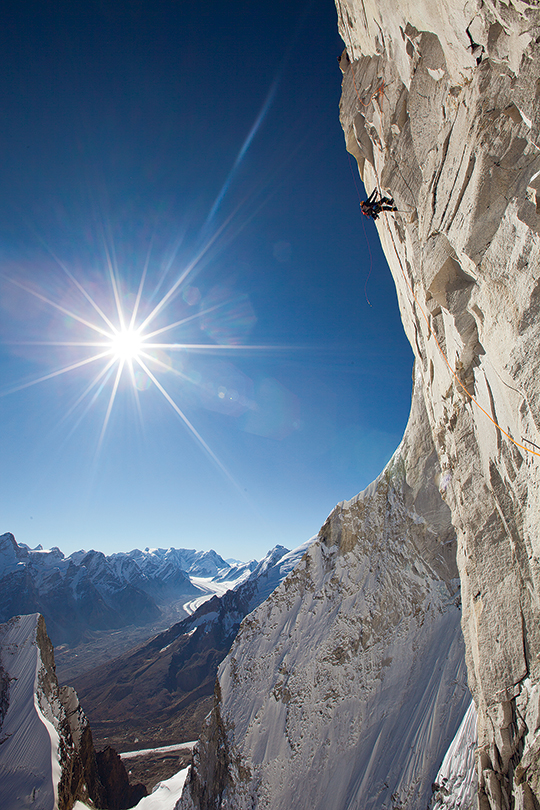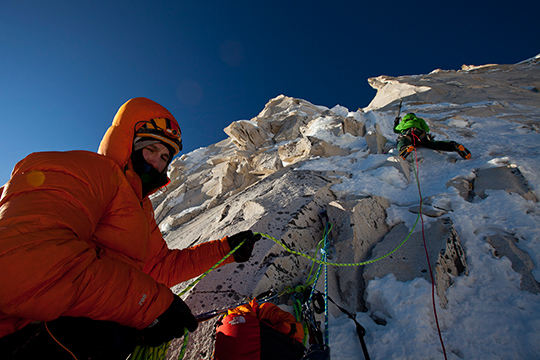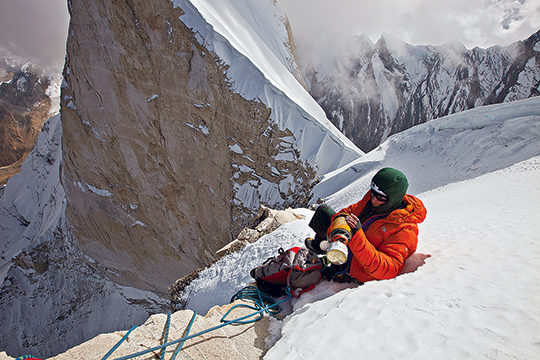
[Photo] Jimmy Chin
People ask for the road to Cold Mountain,
but no road reaches Cold Mountain.
Summer sky–still ice won’t melt.
The sun comes out but gets obscured by mist….
–Han Shan
IN MARCH OF 2011, while skiing in the Tetons, Renan fell off a small cliff. His doctors said he was lucky: although he’d fractured his skull and two vertebrae, and severed a major vertebral artery, his mental acuity would not be compromised. Maybe, as Mugs might say, Ganesh, the mover of obstacles in the Hindu religion, had helped us out. But Renan would have to wear a neck brace for twelve weeks.
Although I figured he wouldn’t be able to recover in time, Renan trained hard for Meru. He, too, I realized, had his own kind of duality. As Jenni said, Renan’s gentle demeanor made him seem “like a soft breeze in a room.” Under the surface, there was a determination as hard and sharp as steel. His doctors didn’t want him to go to Meru. Neither did his girlfriend. But the lure of the peak was too strong, and Renan wouldn’t listen to anyone. “What if he gets an aneurysm or a stroke?” Jenni said. “He shouldn’t be climbing at altitude again so soon.”
Jimmy insisted Renan could manage. To appease Jenni, we invited Chris Figenshau to stay in Base Camp in case of any emergency. During the weeks before we left, I said my good-byes to members of my Bozeman community. They held my hand longer than usual. Jenni’s friends cried. “Hey, we’re just going climbing,” I told them. “It’s supposed to be fun.”
THE STREETS OF DELHI were more crowded than I remembered. Millions of people desperate for a better life had moved into the city. Each day, a deluge beat down on them. The monsoon was heavier than normal. As we left, the skies opened up, flooding the underpasses. Landslides washed out the roads. The first roadblock set us back one day. At Gangotri, the temple bells rang in the moist, sunset air. The calls of birds resounded above the ceaseless river noise. Jimmy, Renan and I went to see Swami Sundaranand, an elderly holy man, to ask whether we should climb Meru. We knew we were merely guests in India. This was their sacred mountain, and if he or any of the others expressed any reluctance, we would turn back.
In his wooden dwelling, the Swami’s gaze had a soft glow like the light on the peak. “Tell us what you see on top,” he said. During his youth, he’d climbed with Sir Edmund Hillary and Tenzing Norgay. After some foreigners gave him a camera, he’d wandered the Gangotri region, taking thousands of photos of the landscape to chronicle the beauty of its shrinking icefields. “In 1949, when I first saw the glacier, I felt as if all my sins were washed away and I had truly attained rebirth,” he’d once told a journalist, Janaki Kremmer. “But now, it is impossible to experience that Ganga of the past.”
Darsan, the Hindu term for blessing, means to encounter the presence of the divine, whether by visiting an ascetic, a temple, a divine river or a holy mountain. By recording such fragile landscapes in images and words, perhaps we could preserve something of that experience for future generations. One day, the glaciers may vanish and the great prow of the Shark’s Fin will fall.
On our last day in town, we gave alms to anyone in saffron robes we could find. We trekked toward Base Camp under cloudbursts of afternoon rain. Pilgrims dressed in sandals and cotton shirts, women in saris, sadhus and babas in loincloths all walked the same path as we did through the dry glacier detritus to Gomukh and Tapovan. Along the Ganges River, the holy men and women strove to renounce the material world. To reach this unobtainable goal, they will endure enormous hardship, suffering cold and hunger. Regardless of where we come from, I realized, there is a degree of sacrifice required to reach our true potential. To take a vow of silence as one of the babas in Tapovan did is true devotion. To create a self-imposed vault of suffering is a rebound from the soft life of Western opulence. Our renunciation would be only a short moment compared to the long hardships of their lives.
On the second morning at Base Camp, the rains stopped, and the horizon expanded. Bathed in alpenglow, the summits of Bhagirathi, Shivling and Meru soared into sacred time.

[Photo] Jimmy Chin
BY THE THIRD DAY, the weather was predictable: a two- to four-hour squall rose from the valley in late afternoon and dissipated at sunset. Once we were familiar with this schedule, we began up the route. Each morning, I woke to the sound of the Ganges River crashing over rocks far below, a sign that the air was still and clear. It was like Alex’s voice, whooping with uncontainable wildness and joy. We reached the balcony camp after twelve pitches of ice on the eve of our first day. As we settled into our bivy ledge, Renan mumbled something incoherent. His face turned pale. I envisioned my late father after his stroke. “Renan, are you OK?” Jimmy and I asked repeatedly. “I’m fine,” he assured us. By morning, he seemed himself again, and he insisted we go on.
Ahead, the granite slabs were dry, and Renan led quickly in rock shoes, with the smooth grace of a free climber moving over stone. In our wide portaledge and warm sleeping bags, we enjoyed the comfort of our little ship on a sea of rock, ice and sky. With each day, the winds became calmer. By the fourth day, I stopped noting the weather in my journal. We never spoke about it, for fear of jinxing our ascent. Pitch by pitch, we progressed fluidly upward, as if carried along by a stream. We’d experienced each ropelength three years earlier, but I had done the individual moves, with miniscule variations, over and over during my thirty years of climbing. The moves and techniques are what we all spend years practicing and perfecting. Now and then, I felt as if I were back on the sandstone of Zion or the granite of Yosemite with Mugs urging me on: We know I can lead this. Let’s see if you can. This was the ultimate test.
The eleventh day on the route, Jimmy aided the final gendarme. Ahead, one more easy ropelength of alpine rock arched toward the summit. “You need to take this pitch, this is your dream climb,” Jimmy said. “No, you take it,” I said. The Shark’s Fin had been Mugs’ dream and then, for while, it had been mine. I was now seven years older than Mugs was when he died. It was already time to pass on that metaphysical ball of knowledge to someone younger. “I want to go last.” One by one, we stepped onto a summit that had seemed a fleeting vision. We sat and took it all in: a sea of glaciated terrain and jutting peaks. We wept in happiness and brewed a cup of coffee–as Alex might have. I had spent eight years of my life on three expeditions and thirty-five nights on the wall to get to this place. After a brief joyous respite, we turned around and began to descend, closing the lesson of Meru in our hearts.
There is something about following through for Mugs in a way he would have respected that has brought me an ultimate peace. As we looked for the path to the “center of the universe,” we understood that difficulty would be part of that path. We never spoke of it, letting the mystique play with our fears and aspirations. The reality, for us, was a rock face, not paradise. But for brief moments of total concentration, that same rock face where we had suffered so much seemed like a paradise, and the mystery of that transformation remains a source of joy. “There is a book of dreams out there,” Mugs once said, “and not enough time to fulfill all the things you dream about.” To be holding the sword of knowledge, even if for only an hour, is the apex of our existence.
I have come to accept that I will never know why we climb.

[Photo] Jimmy Chin
[This story is from Alpinist 38–Spring 2012. To read Alpinist‘s review of the film Meru and to watch the theatrical trailer, click here. Read Chapter 1 here, Chapter 2 here and Chapter 3 here.–Ed]
[Explanations of Hindu sacred landscapes were provided by Dr. Meera Baindur of India’s Manipal University and also found in Diana Eck’s book, Darsan: Seeing the Divine Image in India, 1998 and Anuradha Roma Choudhury’s “Hinduism,” Sacred Place, ed. Jean Holm and John Bowker, 1994. The role of “Meru” in Buddhist and Hindu philosophy is described in I. W. Mabbett’s “The Symbolism of Meru,” History of Religions, vol. 23, no. 1 (August 1983); and in Donald S. Lopez’s Buddhism and Science: A Guide for the Perplexed, 2008. Additional information about Mugs Stump came from interviews with Scott Backes and Steve Quinlan–Ed.]